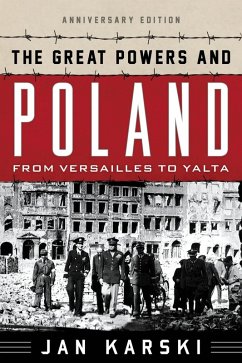57,95 €
57,95 €
inkl. MwSt.
Sofort per Download lieferbar

29 °P sammeln
57,95 €
Als Download kaufen

57,95 €
inkl. MwSt.
Sofort per Download lieferbar

29 °P sammeln
Jetzt verschenken
Alle Infos zum eBook verschenken
57,95 €
inkl. MwSt.
Sofort per Download lieferbar
Alle Infos zum eBook verschenken

29 °P sammeln
- Format: PDF
- Merkliste
- Auf die Merkliste
- Bewerten Bewerten
- Teilen
- Produkt teilen
- Produkterinnerung
- Produkterinnerung

Bitte loggen Sie sich zunächst in Ihr Kundenkonto ein oder registrieren Sie sich bei
bücher.de, um das eBook-Abo tolino select nutzen zu können.
Hier können Sie sich einloggen
Hier können Sie sich einloggen
Sie sind bereits eingeloggt. Klicken Sie auf 2. tolino select Abo, um fortzufahren.

Bitte loggen Sie sich zunächst in Ihr Kundenkonto ein oder registrieren Sie sich bei bücher.de, um das eBook-Abo tolino select nutzen zu können.
This definitive study provides a comprehensive diplomatic history of Poland during the most seminal period in its existence, when its destiny lay in the hands of France, Great Britain, and the United States. Although sovereign in principle, Poland was little more than an object of the Great Powers' politics and rapidly changing relationships from the end of WWI to the end of WWII. Focusing on the shifting policies of the Great Powers toward Poland from the Treaty of Versailles to Yalta, the book ends with Poland's tragic abandonment by the West into the hands of the Soviet Union. Enriched by…mehr
- Geräte: PC
- mit Kopierschutz
- eBook Hilfe
- Größe: 2.24MB
Andere Kunden interessierten sich auch für
![The Great Powers and Poland (eBook, ePUB) The Great Powers and Poland (eBook, ePUB)]() Jan KarskiThe Great Powers and Poland (eBook, ePUB)57,95 €
Jan KarskiThe Great Powers and Poland (eBook, ePUB)57,95 €![Communist Poland (eBook, PDF) Communist Poland (eBook, PDF)]() Sara Nomberg-PrzytykCommunist Poland (eBook, PDF)65,95 €
Sara Nomberg-PrzytykCommunist Poland (eBook, PDF)65,95 €![Ukrainian Female War Migrants (eBook, PDF) Ukrainian Female War Migrants (eBook, PDF)]() Izabela GrabowskaUkrainian Female War Migrants (eBook, PDF)42,95 €
Izabela GrabowskaUkrainian Female War Migrants (eBook, PDF)42,95 €![The Politics of Memory in Poland and Ukraine (eBook, PDF) The Politics of Memory in Poland and Ukraine (eBook, PDF)]() The Politics of Memory in Poland and Ukraine (eBook, PDF)41,95 €
The Politics of Memory in Poland and Ukraine (eBook, PDF)41,95 €![The Irish-American Experience in New Jersey and Metropolitan New York (eBook, PDF) The Irish-American Experience in New Jersey and Metropolitan New York (eBook, PDF)]() The Irish-American Experience in New Jersey and Metropolitan New York (eBook, PDF)36,95 €
The Irish-American Experience in New Jersey and Metropolitan New York (eBook, PDF)36,95 €![Balkan Genocides (eBook, PDF) Balkan Genocides (eBook, PDF)]() Paul MojzesBalkan Genocides (eBook, PDF)25,95 €
Paul MojzesBalkan Genocides (eBook, PDF)25,95 €![Women in Eastern European Post-Socialist Countries (eBook, PDF) Women in Eastern European Post-Socialist Countries (eBook, PDF)]() Women in Eastern European Post-Socialist Countries (eBook, PDF)42,95 €
Women in Eastern European Post-Socialist Countries (eBook, PDF)42,95 €-
-
-
This definitive study provides a comprehensive diplomatic history of Poland during the most seminal period in its existence, when its destiny lay in the hands of France, Great Britain, and the United States. Although sovereign in principle, Poland was little more than an object of the Great Powers' politics and rapidly changing relationships from the end of WWI to the end of WWII. Focusing on the shifting policies of the Great Powers toward Poland from the Treaty of Versailles to Yalta, the book ends with Poland's tragic abandonment by the West into the hands of the Soviet Union. Enriched by unique anecdotal and archival material, this book will be essential reading for all those seeking to understand Poland's role in twentieth-century history.
Produktdetails
- Produktdetails
- Verlag: Bloomsbury eBooks US
- Seitenzahl: 540
- Erscheinungstermin: 16. Januar 2014
- Englisch
- ISBN-13: 9798216263449
- Artikelnr.: 74833061
- Verlag: Bloomsbury eBooks US
- Seitenzahl: 540
- Erscheinungstermin: 16. Januar 2014
- Englisch
- ISBN-13: 9798216263449
- Artikelnr.: 74833061
- Herstellerkennzeichnung Die Herstellerinformationen sind derzeit nicht verfügbar.
Jan Karski (1914-2000) was a young diplomat when Hitler invaded Poland in 1939. Taken prisoner by the Soviet Red Army, Karski escaped and joined the Polish underground. He infiltrated both the Warsaw Ghetto and a German concentration camp and then carried the first eyewitness accounts of the Holocaust to a mostly disbelieving West. After World War II, Karski earned a Ph.D. from Georgetown University, where he served as a distinguished professor in the School of Foreign Service for forty years.
Part I: The Great Powers and Poland between the Two World Wars (1919-1939)
Chapter 1: The Polish Question during World War I
Chapter 2: The Versailles Peace Conference, January 18-June 28, 1919
Chapter 3: The Polish-Bolshevik War and the Curzon Line
Chapter 4: Poland's Eastern, Northern, and Southern Boundaries: A Profile
of the Reborn State
Chapter 5: German-Soviet Secret Understanding, 1919-1932
Chapter 6: Poland in the Foreign Policy of France, 1921-1932
Chapter 7: Two-Faced Eastern Neighbor, 1921-1932
Chapter 8: The Crucial Year, 1933
Chapter 9: The Polish-German Declaration of Nonaggression, January 26, 1934
Chapter 10: Franco-Polish Relations, 1933-1936
Chapter 11: The Era of Appeasement, 1937-1938
Chapter 12: France and Poland after the Remilitarization of the Rhineland
Chapter 13: Hitler's Demands on Poland, October 1938-March 1939
Chapter 14: Soviet-Polish Relations, 1934-1938
Chapter 15: The Meaning of the British and French Guarantees, March-April
1939
Chapter 16: Hitler's Decision to Isolate and Crush Poland, April-August
1939
Chapter 17: Nazi-Polish Relations and the Problem of Russia
Chapter 18: Hitler-Beck Diplomacy: A Make-Believe World
Chapter 19: Anglo-French-Polish Military and Economic Agreements:
Commitments in Bad Faith, 1939
Chapter 20: War and Peace in Soviet Diplomacy, 1939
Chapter 21: The Anglo-Polish Pact of Mutual Assistance: Poland Misled,
August 25, 1939
Chapter 22: France, Great Britain, and Russia during the German-Polish
Campaign
Part II: The Great Powers and Poland during the Second World War
(1939-1945)
Chapter 23: Poland after Defeat
Chapter 24: The Polish-Soviet Pact of July 30, 1941
Chapter 25: The "Four Freedoms" and the Atlantic Charter
Chapter 26: Soviet-Polish Relations, July 30, 1941-April 25, 1943
Chapter 27: The British-Soviet Alliance of May 26, 1942: Churchill's Secret
Diplomacy
Chapter 28: British and American Attitudes toward Poland, 1941-1943
Chapter 29: The Tehran Conference: Roosevelt's Secret Diplomacy, November
28-December 1, 1943
Chapter 30: The Entry of the Red Army into Poland, January 1944
Chapter 31: Churchill's Efforts to Implement the Polish "Formula"
Chapter 32: Roosevelt and the Polish Issue on the Eve of the 1944
Presidential Election Campaign
Chapter 33: The Warsaw Uprising, August 1-October 2, 1944
Chapter 34: The Poles Entrapped in the Homeland and Abroad, August-October
1944
Chapter 35: The Aftermath of the October Conference in Moscow
Chapter 36: Prologue to the Yalta Conference
Chapter 37: The Yalta Conference, February 4-11, 1945
Chapter 38: The Meaning of the Yalta Agreement: Diplomacy and Semantics
Epilogue
Bibliography
Chapter 1: The Polish Question during World War I
Chapter 2: The Versailles Peace Conference, January 18-June 28, 1919
Chapter 3: The Polish-Bolshevik War and the Curzon Line
Chapter 4: Poland's Eastern, Northern, and Southern Boundaries: A Profile
of the Reborn State
Chapter 5: German-Soviet Secret Understanding, 1919-1932
Chapter 6: Poland in the Foreign Policy of France, 1921-1932
Chapter 7: Two-Faced Eastern Neighbor, 1921-1932
Chapter 8: The Crucial Year, 1933
Chapter 9: The Polish-German Declaration of Nonaggression, January 26, 1934
Chapter 10: Franco-Polish Relations, 1933-1936
Chapter 11: The Era of Appeasement, 1937-1938
Chapter 12: France and Poland after the Remilitarization of the Rhineland
Chapter 13: Hitler's Demands on Poland, October 1938-March 1939
Chapter 14: Soviet-Polish Relations, 1934-1938
Chapter 15: The Meaning of the British and French Guarantees, March-April
1939
Chapter 16: Hitler's Decision to Isolate and Crush Poland, April-August
1939
Chapter 17: Nazi-Polish Relations and the Problem of Russia
Chapter 18: Hitler-Beck Diplomacy: A Make-Believe World
Chapter 19: Anglo-French-Polish Military and Economic Agreements:
Commitments in Bad Faith, 1939
Chapter 20: War and Peace in Soviet Diplomacy, 1939
Chapter 21: The Anglo-Polish Pact of Mutual Assistance: Poland Misled,
August 25, 1939
Chapter 22: France, Great Britain, and Russia during the German-Polish
Campaign
Part II: The Great Powers and Poland during the Second World War
(1939-1945)
Chapter 23: Poland after Defeat
Chapter 24: The Polish-Soviet Pact of July 30, 1941
Chapter 25: The "Four Freedoms" and the Atlantic Charter
Chapter 26: Soviet-Polish Relations, July 30, 1941-April 25, 1943
Chapter 27: The British-Soviet Alliance of May 26, 1942: Churchill's Secret
Diplomacy
Chapter 28: British and American Attitudes toward Poland, 1941-1943
Chapter 29: The Tehran Conference: Roosevelt's Secret Diplomacy, November
28-December 1, 1943
Chapter 30: The Entry of the Red Army into Poland, January 1944
Chapter 31: Churchill's Efforts to Implement the Polish "Formula"
Chapter 32: Roosevelt and the Polish Issue on the Eve of the 1944
Presidential Election Campaign
Chapter 33: The Warsaw Uprising, August 1-October 2, 1944
Chapter 34: The Poles Entrapped in the Homeland and Abroad, August-October
1944
Chapter 35: The Aftermath of the October Conference in Moscow
Chapter 36: Prologue to the Yalta Conference
Chapter 37: The Yalta Conference, February 4-11, 1945
Chapter 38: The Meaning of the Yalta Agreement: Diplomacy and Semantics
Epilogue
Bibliography
Part I: The Great Powers and Poland between the Two World Wars (1919-1939)
Chapter 1: The Polish Question during World War I
Chapter 2: The Versailles Peace Conference, January 18-June 28, 1919
Chapter 3: The Polish-Bolshevik War and the Curzon Line
Chapter 4: Poland's Eastern, Northern, and Southern Boundaries: A Profile
of the Reborn State
Chapter 5: German-Soviet Secret Understanding, 1919-1932
Chapter 6: Poland in the Foreign Policy of France, 1921-1932
Chapter 7: Two-Faced Eastern Neighbor, 1921-1932
Chapter 8: The Crucial Year, 1933
Chapter 9: The Polish-German Declaration of Nonaggression, January 26, 1934
Chapter 10: Franco-Polish Relations, 1933-1936
Chapter 11: The Era of Appeasement, 1937-1938
Chapter 12: France and Poland after the Remilitarization of the Rhineland
Chapter 13: Hitler's Demands on Poland, October 1938-March 1939
Chapter 14: Soviet-Polish Relations, 1934-1938
Chapter 15: The Meaning of the British and French Guarantees, March-April
1939
Chapter 16: Hitler's Decision to Isolate and Crush Poland, April-August
1939
Chapter 17: Nazi-Polish Relations and the Problem of Russia
Chapter 18: Hitler-Beck Diplomacy: A Make-Believe World
Chapter 19: Anglo-French-Polish Military and Economic Agreements:
Commitments in Bad Faith, 1939
Chapter 20: War and Peace in Soviet Diplomacy, 1939
Chapter 21: The Anglo-Polish Pact of Mutual Assistance: Poland Misled,
August 25, 1939
Chapter 22: France, Great Britain, and Russia during the German-Polish
Campaign
Part II: The Great Powers and Poland during the Second World War
(1939-1945)
Chapter 23: Poland after Defeat
Chapter 24: The Polish-Soviet Pact of July 30, 1941
Chapter 25: The "Four Freedoms" and the Atlantic Charter
Chapter 26: Soviet-Polish Relations, July 30, 1941-April 25, 1943
Chapter 27: The British-Soviet Alliance of May 26, 1942: Churchill's Secret
Diplomacy
Chapter 28: British and American Attitudes toward Poland, 1941-1943
Chapter 29: The Tehran Conference: Roosevelt's Secret Diplomacy, November
28-December 1, 1943
Chapter 30: The Entry of the Red Army into Poland, January 1944
Chapter 31: Churchill's Efforts to Implement the Polish "Formula"
Chapter 32: Roosevelt and the Polish Issue on the Eve of the 1944
Presidential Election Campaign
Chapter 33: The Warsaw Uprising, August 1-October 2, 1944
Chapter 34: The Poles Entrapped in the Homeland and Abroad, August-October
1944
Chapter 35: The Aftermath of the October Conference in Moscow
Chapter 36: Prologue to the Yalta Conference
Chapter 37: The Yalta Conference, February 4-11, 1945
Chapter 38: The Meaning of the Yalta Agreement: Diplomacy and Semantics
Epilogue
Bibliography
Chapter 1: The Polish Question during World War I
Chapter 2: The Versailles Peace Conference, January 18-June 28, 1919
Chapter 3: The Polish-Bolshevik War and the Curzon Line
Chapter 4: Poland's Eastern, Northern, and Southern Boundaries: A Profile
of the Reborn State
Chapter 5: German-Soviet Secret Understanding, 1919-1932
Chapter 6: Poland in the Foreign Policy of France, 1921-1932
Chapter 7: Two-Faced Eastern Neighbor, 1921-1932
Chapter 8: The Crucial Year, 1933
Chapter 9: The Polish-German Declaration of Nonaggression, January 26, 1934
Chapter 10: Franco-Polish Relations, 1933-1936
Chapter 11: The Era of Appeasement, 1937-1938
Chapter 12: France and Poland after the Remilitarization of the Rhineland
Chapter 13: Hitler's Demands on Poland, October 1938-March 1939
Chapter 14: Soviet-Polish Relations, 1934-1938
Chapter 15: The Meaning of the British and French Guarantees, March-April
1939
Chapter 16: Hitler's Decision to Isolate and Crush Poland, April-August
1939
Chapter 17: Nazi-Polish Relations and the Problem of Russia
Chapter 18: Hitler-Beck Diplomacy: A Make-Believe World
Chapter 19: Anglo-French-Polish Military and Economic Agreements:
Commitments in Bad Faith, 1939
Chapter 20: War and Peace in Soviet Diplomacy, 1939
Chapter 21: The Anglo-Polish Pact of Mutual Assistance: Poland Misled,
August 25, 1939
Chapter 22: France, Great Britain, and Russia during the German-Polish
Campaign
Part II: The Great Powers and Poland during the Second World War
(1939-1945)
Chapter 23: Poland after Defeat
Chapter 24: The Polish-Soviet Pact of July 30, 1941
Chapter 25: The "Four Freedoms" and the Atlantic Charter
Chapter 26: Soviet-Polish Relations, July 30, 1941-April 25, 1943
Chapter 27: The British-Soviet Alliance of May 26, 1942: Churchill's Secret
Diplomacy
Chapter 28: British and American Attitudes toward Poland, 1941-1943
Chapter 29: The Tehran Conference: Roosevelt's Secret Diplomacy, November
28-December 1, 1943
Chapter 30: The Entry of the Red Army into Poland, January 1944
Chapter 31: Churchill's Efforts to Implement the Polish "Formula"
Chapter 32: Roosevelt and the Polish Issue on the Eve of the 1944
Presidential Election Campaign
Chapter 33: The Warsaw Uprising, August 1-October 2, 1944
Chapter 34: The Poles Entrapped in the Homeland and Abroad, August-October
1944
Chapter 35: The Aftermath of the October Conference in Moscow
Chapter 36: Prologue to the Yalta Conference
Chapter 37: The Yalta Conference, February 4-11, 1945
Chapter 38: The Meaning of the Yalta Agreement: Diplomacy and Semantics
Epilogue
Bibliography







